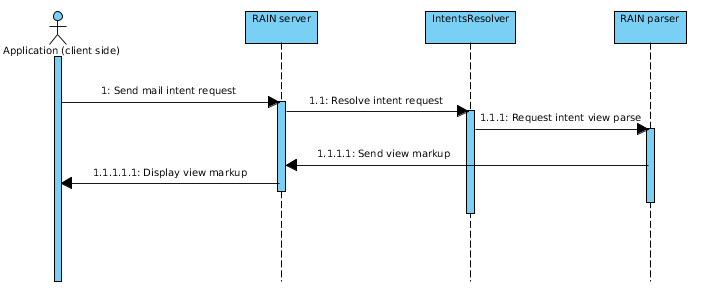Messaging API¶
Client messaging layer is part of client runtime. In RAIN you have two types of messaging on the client side:
- Intents messaging
- Publish / subscriber
Intents¶
Intents concept is inspired from the Android operating system. Basically they allow the developer to express an action that should be executed without being “aware” of the provider. The only thing the developer must know is what data can be passed to that action.
For instance imagine an action called LOG_EVENT. To be able to execute this action you must know that an event is described by a message, a timestamp and an optional description.
Using intents it is really easy to create a product in which each fragment of functionality can be easily changed without affecting existing code. Moreover, there might be situations when multiple action providers exists. The platform will allow user to select what provider to use.
Intents lifecycle¶
It is really important to know that when expressing an intent the developer will be able to send a JSON object that holds specific information. For instance, when sending an email you already know where you want to send it. The expected behavior is to receive back the send mail application with all fields completed.

Intents Usage¶
Messaging layer can be used directly from the controller’s context. Each client side controller has access to all its methods. Below you can find an usage example:
var messaging = this.context.messaging;
var request = {
viewContext: self.viewContext,
category: "local_test_intent",
action: "local_action",
intentContext: {"message": "This will not work."}
};
var intent = messaging.sendIntent(request);
var fnSuccess = function(data) { alert(JSON.stringify(data)); };
var fnError = function(ex) { alert(ex.message); };
intent.then(fnSuccess, fnError);
The above example is extracted from the samples provided by RAIN (intents_example). The method used to accessing intents mechanism is sendIntent method. This method accept a Dictionary as a parameter. Each intent request must contain the following information:
- viewContext - This is the requester viewContext object.
- category - This is the intent category as defined in meta.json file.
- action - This is the action of the intent.
- intentContext - This is a dictionary where data specific to the intent are passed.
The sendIntent method returns a promise that can be used to react onsuccess and onerror. If you do not specify a callback for error case then the error is automatically thrown.
Publish / Subscriber¶
The publish/subscribe mechanism is an implementation of the observer pattern, and it can be found in the messaging object. The way pub/sub works is that you can subscribe to an event, without needing to know if the publisher exists or is even initialized, and this gives you a very loosely coupled approach. Lets see a usage example:
var messaging = this.context.messaging;
// subscribe to an event
messaging.subscribe('sliderReady', function (data) {
console.log(data);
}, this.context);
// publish an event
messaging.publish('sliderReady', {success: true}, this.context);
Now, what this does it that it subscribes to the sliderReady event, and then publishes it. The arguments are pretty obvious, the first one is the event name, the second one is the callback (for the subscriber) or the data (for the publisher) and the context (used internally for scoping). We also provided some aliases to these methods on the context object which do not require the last argument.
We also provide the possibility of namespacing your events, by separating them with the _::_ operator. This allows you to scope your events, or if you want to, to subscribe to global events by prefixing your event with the :: operator. But enough talk, lets see some code:
// Subscribe to a local event.
this.context.subscribe('localEvent', function (data) {
console.log('local event triggered');
});
// Subscribe to a global event.
this.context.subscribe('::globalEvent', function (data) {
console.log('global event triggered');
});
// Publish the global event.
this.context.publish('::globalEvent');